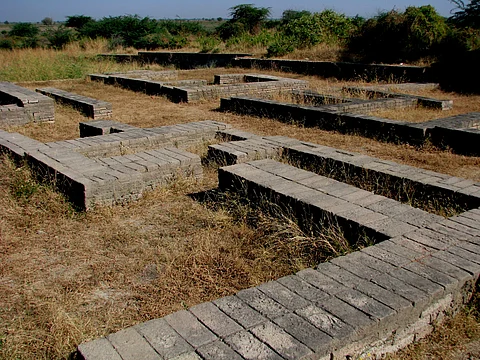
- Destinations
- Experiences
- Stay
- What's new
- Celebrating People
- Responsible Tourism
- CampaignsCampaigns
- SubscribeSubscribe
- Buy Now

Long ago between the year 3300 and 1300 BCE, one of the oldest urban cultures in the world flourished and occupied modern-day India and Pakistan. Even then, the civilisation was advanced with well-planned cities, sophisticated drainage systems and baked brick houses, among many other things. Lothal, now in modern-day Gujarat, was a thriving trade centre and supposedly the world's earliest known dock. It linked the Indus Valley Civilisation with Mesopotamia and other far flung regions.
Translated literally, Lothal means "Mound of the Dead" in Gujarati. The site was discovered in 1954 by archaeologist S.R. Rao and excavations went on from 1955 to 1962 by the Archaeological Survey of India (ASI). The site dates back to around 2400 BCE and is known to have been the integral part of the larger Indus Valley network. Unlike Harappa and Mohenjo-Daro, which were more inland, Lothal played a vital role as a maritime trade hub, making exchange of goods such as semi-precious stones, beads, ivory and cotton easy with the ancient Mesopotamian and Persian Gulf civilisations.
The prosperity and importance of Lothal declined around 1900 BCE, possibly due to climatic changes, shifts in river courses, or natural calamities. Nevertheless, the remnants of this once thriving town continue to provide insights into the technological and urban advancements of the Indus Valley people.
Lothal's meticulously designed dockyard, which is said to be the oldest dock in the world, is among its most amazing finds. The dockyard, which was connected to the Bhogava River, which led to the Gulf of Khambhat, was about 37 m long and 22 m broad. This intricate building showcased the civilisation's understanding of tides, water control, and flood management while facilitating marine trade and exhibiting sophisticated hydraulic engineering.
Archaeologists discovered a huge warehouse next to the dockyard that was used to hold commodities like cotton, beads, and spices before they were exchanged with other civilisations. The existence of thoughtfully planned platforms highlights the city's status as a thriving commercial centre and points to an effective trade management system.
Lothal was a significant hub for metalworking and beadwork. There is evidence of a well-organised bead industry at the site, with craftspeople using semi-precious stones including carnelian, agate, and jasper to create beautiful jewellery. Lothal's significance in international commerce networks was further highlighted by the strong demand for these beads throughout the Mesopotamian and Indus Valley regions.
Lothal had a carefully thought-out layout, complete with residential zones, drainage systems, and broad roads, just like other Indus Valley Civilisation cities. The high standard of living among its residents was reflected in the baked brick homes, which featured several rooms, wells, and bathrooms. The Indus Valley people's sophisticated urban planning abilities are further evidenced by the existence of a well-connected drainage system.
The Archaeological Survey of India is responsible for maintaining the well-preserved archaeological site at Lothal today. The remains of the warehouse, residential neighbourhoods, bead manufacturers, and dockyard are open to visitors. A greater knowledge of the everyday lives and commercial endeavours of the early settlers is possible thanks to the vast collection of items housed in the on-site museum, which includes ceramics, tools, beads, and seals.
In addition, Lothal also provides visitors and history buffs with an intriguing look into one of the oldest marine civilisations in history. It is reachable by road from Ahmedabad, about 80 km away, and offers a fascinating day journey into India's ancient past.
The rare and elegant blackbuck antelope can be seen in this reserve, which is around 100 kms from Lothal. Wildlife lovers get a fantastic chance to see wolves, blackbucks, and a range of migratory species in their native environment at the park.
Situated about 90 kms away, Nal Sarovar is a paradise for birdwatchers. During winter, thousands of migratory birds flock to this vast wetland, making it a perfect spot for nature lovers and photographers.
A trip to Ahmedabad's Sarkhej Roza is worthwhile for anyone interested in Indo-Islamic architecture. This magnificent complex of pavilions, mosques, and tombs exhibits historical significance and fine craftsmanship.
The Modhera Sun Temple, a stunning example of Solanki-era architecture, is situated roughly 130 kms from Lothal. The temple, which is devoted to the Sun God, has a magnificent stepwell with elaborate carvings.
Air: The nearest airport is in Ahmedabad (91 kms). Hire a cab or rented car for a 2.5–3 hrs journey.
Rail: Bhurkhi Railway Station on the Ahmedabad–Bhavnagar line is the nearest. Local buses and autos are available from there.
Road: Driving from Ahmedabad is convenient and allows for sightseeing en route. Rental services offer sedans, SUVs, and tempo travellers. Alternatively, you can also take a bus from Ahmedabad’s Geeta Mandir to Bagodara (1.5–2 hrs), then a shared auto to Arnej railway crossing. The last 10 kms to Lothal can be covered by a local auto.
